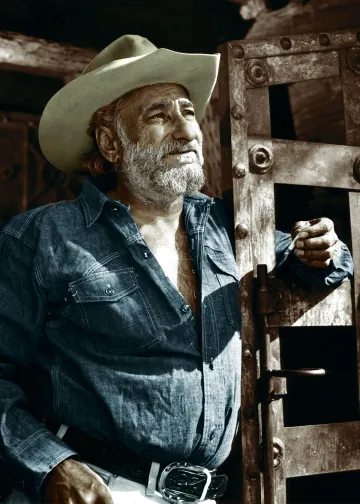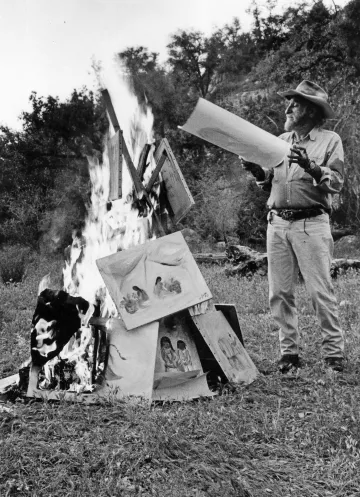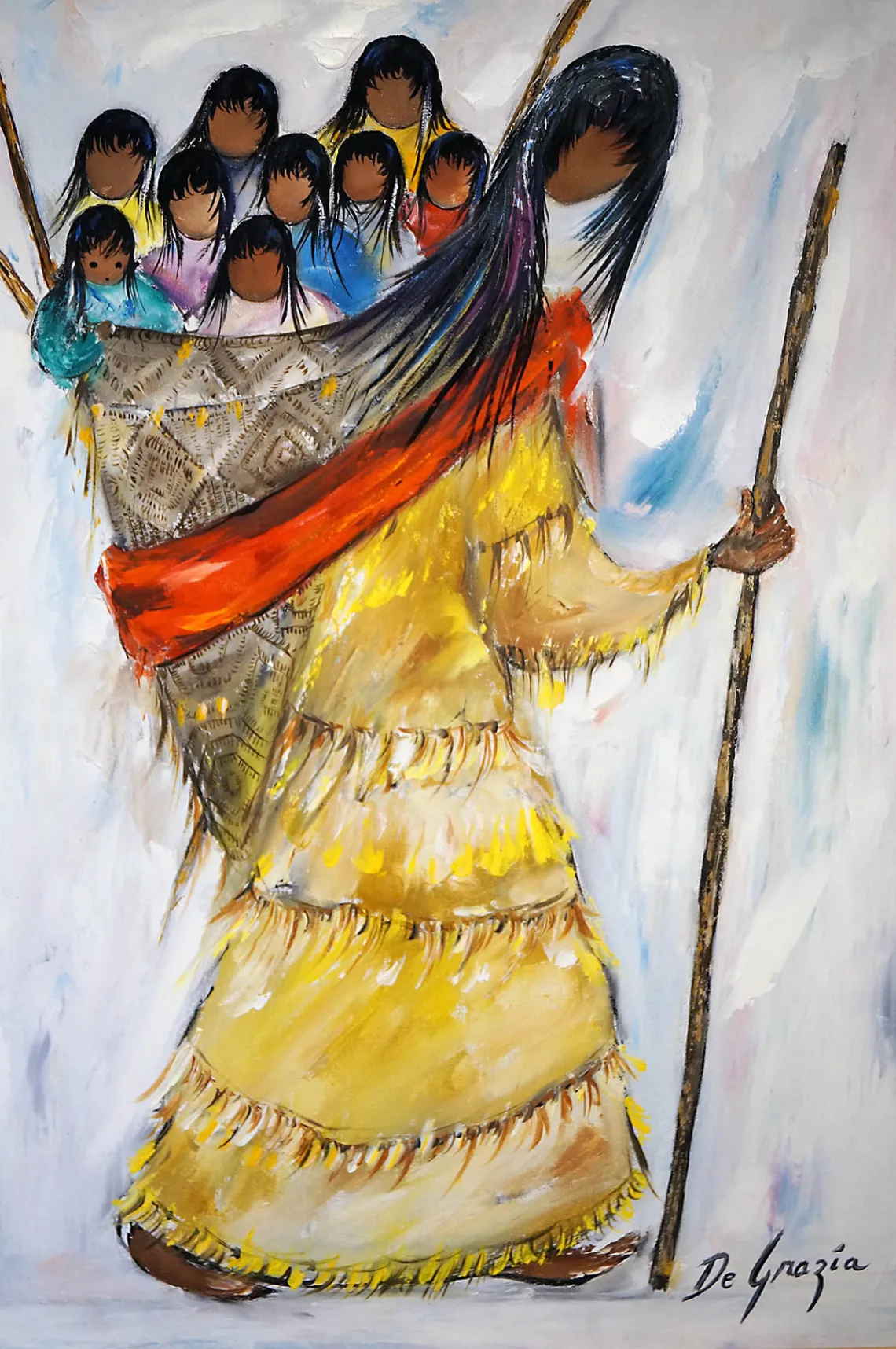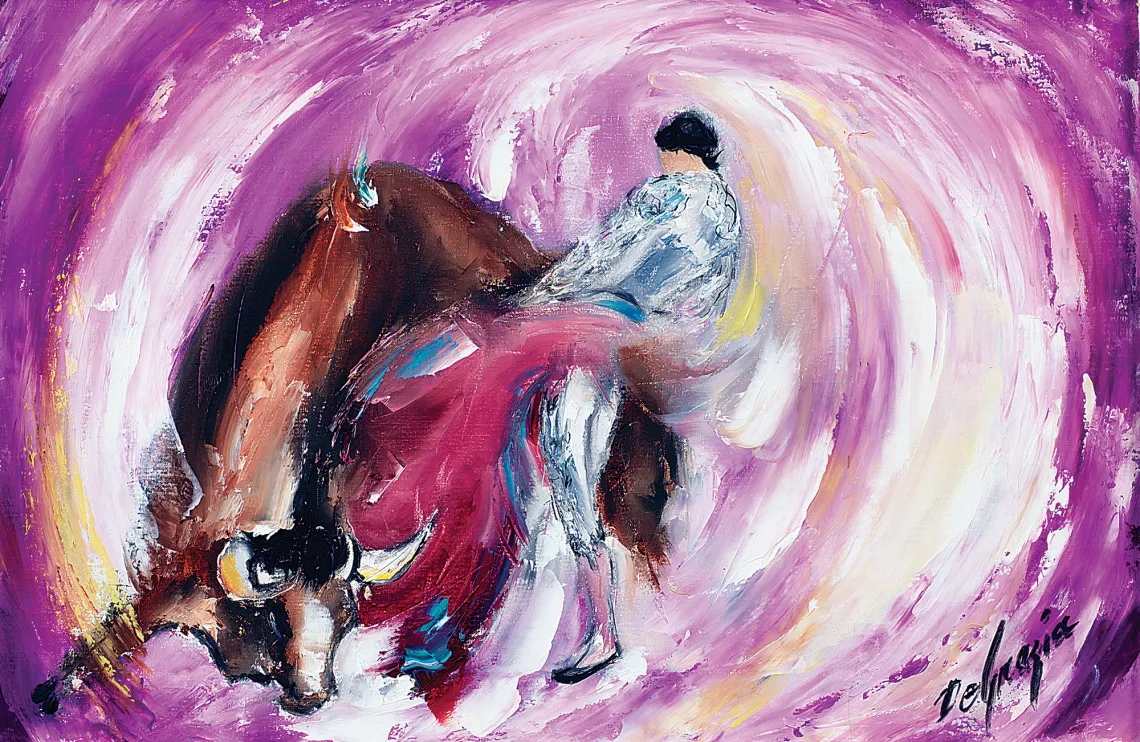Ted DeGrazia

Ettore “Ted” DeGrazia, archival photo
/ Photo courtesy of the DeGrazia Foundation
If it hadn’t been for the copper mines of Morenci, Arizona Territory, little Ettore DeGrazia might never have become the hard-nosed artist Ted DeGrazia.
His parents, Domenico and Lucia, were Italian immigrants who came to the U.S. with streams of other foreigners looking for work. Domenico labored underground in the dark of the mines from sunup to sundown, while Lucia tended to their brood. Ted was born in 1909, the third of the seven hungry children who needed to be fed on their father’s poor wages.
Life could be bleak — especially during the mine’s periodic shutdowns. But the family loved playing musical instruments, and as they grew older Ted and his brothers played in a combo band. Ted also was enamored of the desert’s beauty, and he started making art as a little boy.
James W. Johnson, a now-retired journalism professor at the University of Arizona, wrote “DeGrazia: The Man and the Myths” with his wife Marilyn D. Johnson. Published in 2014 by University of Arizona Press, Johnson’s biography gives us much of what we know of DeGrazia’s life.

To protest inheritance taxes on works of art, DeGrazia hauled about 100 of his paintings on horseback into the Superstition Mountains near Phoenix and set them ablaze in 1976.
/ Photo courtesy of the DeGrazia Foundation
Johnson writes that young Ted made flowers, animals and birds out of colored paper, which he then sold for pennies. As he grew older, he was inspired by the colorful stained-glass saints and martyrs looking down at the faithful in candlelit Catholic churches. One of his early works was a portrait of a suffering Jesus — in the form of a bread sculpture baked in his mother’s kitchen, inspired by a painting she had brought from Italy.
As an adult, the multitalented DeGrazia made art, music, books and even ballet stories that were performed by a dance troupe. He also was an architect, designing and building a much-admired home/studio in midtown Tucson and another in the foothills, below Finger Rock in the Catalina Mountains. That 10-acre plot is now home to a museum called the DeGrazia Gallery in the Sun, open to the public.
Despite his accomplishments, DeGrazia was known to be difficult and hold grudges.
According to Johnson, DeGrazia once declared that he was “not saint nor devil, but both.” He admitted that he neglected his family (he married twice, keeping a long-time lover during his second marriage, and had four children). He despised art critics. And though he studied at the University of Arizona on and off for 13 years, eventually earning a double master’s in music and art, he often tangled with school officials.
In a way, it was the Morenci mine that brought DeGrazia to UArizona. He had worked there a bit after high school, and he saw his father’s hardships. He had no intention of spending his life down in the mine.
Phelps Dodge shut down its underground operations in the late ’20s. Mine jobs disappeared, and as the Great Depression rolled on, jobs of all kinds were fewer and fewer. Ted wasn’t keen on college, but he didn’t have much choice. In 1932 he arrived in Tucson and signed up to major in music and art.
The campus was beautiful, there were new friends aplenty, and he liked his music professors. One had even played in the John Philip Sousa Band. DeGrazia joined the school concert band on trumpet, and to earn money, he formed his own 10-piece ensemble on the side.

The late artist Ted DeGrazia’s much-admired home and studio beneath Finger Rock in the foothills of the Catalina Mountains, which today is the DeGrazia museum. He designed and built another home/studio in midtown Tucson.
/ Chris Richards photo
But by and large, DeGrazia didn’t care for his art classes. He did warm up to Katherine Kitt, a beloved professor who recognized his talent. But other professors, he complained, insisted on old-fashioned art exercises that he felt were a waste of his time.
“I had come to school because I was a painter, not to become one,” he once declared.
In 1936, he bailed from college — for a time — after marrying his college sweetheart, Alexandra Diamos, whose father owned movie theaters around the state. The pair moved to Bisbee, where DeGrazia was to manage a cinema. But he didn’t give up painting.
The year before, the university had done something marvelous that changed DeGrazia’s idea of art: It had mounted an exhibition of work by Diego Rivera and José Clemente Orozco, two titans of Mexican art. Their stunning paintings honored the poor, especially the Indigenous peoples of Mexico. DeGrazia was enthralled.
After he moved to Bisbee, he made an extraordinary painting in the style of Rivera and Orozco. But DeGrazia’s painting was about his own world: the mines and the miners of Morenci. The three-panel work, titled “Mining,” depicted the darkness below, the machinery and the smoke spewing out from the stacks. In the center, a helmeted miner bends over his tools in the shadows. The figure could easily be his father, who eventually died of lung disease.
A few years later, DeGrazia managed to meet Rivera in his studio in Mexico City. To his amazement, the great artist liked DeGrazia’s pictures and invited him to stay for two months as a student assistant. The young artist did lowly work, sweeping the floors, but Rivera also advised him to do a series of 20 paintings in a desperate neighborhood where he could see and paint the tragedies of the poor.
And Orozco invited him to work on a mural painted on a corner of a hospital.
Before he left town, DeGrazia showed his art in the prestigious Palacio de Bellas Artes. Returning home with positive reviews and letters from his two famous patrons, he was confident that his own university would give him an exhibition. But it declined and, as Johnson says, DeGrazia never forgot the slight.

The DeGrazia Gallery in the Sun is as much a piece of art as the works on display.
/ Chris Richards photo
Nevertheless, DeGrazia returned to school. In 1944, the editor of the Wildcat, the student newspaper, invited him to paint a mural in the paper’s office. DeGrazia agreed, and he unleashed his anger in a painting denouncing the university’s values, making a kaleidoscope of wild horses and skeletons wearing graduation caps.
Before long, the university higher-ups discovered the art, which they considered a travesty. A worker was dispatched to the journalism headquarters with orders to destroy the mural, ironically named “Power of the Press.” The deed was done with a bucket of whiteout, Johnson writes.
DeGrazia felt that he had been destroyed himself. He finished his master’s degree the following year, but had little to do with the university until several decades later.
During those years, he became an international artist with great financial success. His first break came when Arizona Highways magazine began featuring his paintings. Then, in 1960, UNICEF chose “Los Niños” — a painting of Native American children dancing — for a Christmas card. The card sold in the millions; the barefoot boy of Morenci became a star.
He abandoned the serious styles of Rivera and Orozco and made happier and brighter work, mostly images of Tohono O’odham and Yaqui peoples. His critics skewered this new work, which they considered campy commercialism. DeGrazia himself argued that he was still painting pictures of the poor.
In 1972, the university finally approached him to do a solo show at the University of Arizona Museum of Art. DeGrazia was still angry at his alma mater, but after some prickly negotiations he agreed. One hundred and nine paintings hung for nine weeks, and the exhibition was a hit all around town.
DeGrazia died in 1982. In 1998, the UArizona Museum of Art mounted the show “Tucson’s Early Moderns: 1945-1965,” curated by Maurice Grossman and recognizing important Tucson artists. Eight of DeGrazia’s paintings, mostly from his early career, were on view.



